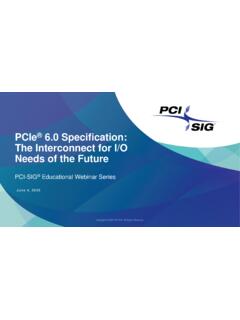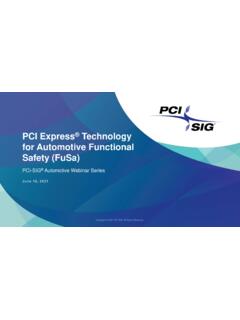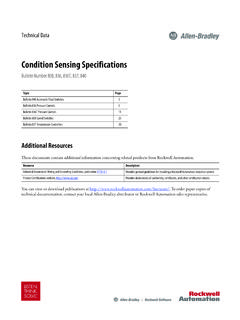Transcription of PCI Express Electrical Signaling
1 PCI Express Electrical Basics Rick Eads Keysight Technologies Copyright 2014, PCI-SIG, All Rights Reserved 1. Topics PCI Express Overview Enhancements for 8GT/s Target channels for the specification Electrical Signaling Transmitter Receiver SEASIM. PCIe Technology Seminar Copyright 2014, PCI-SIG, All Rights Reserved 2. Electrical Features Data rates , 5GT/s and 8GT/s 10-12 bit error ratio AC coupled Link widths 1, 2, 4, 8, 16, 32 lanes Hot swap capable and 5GT/s scrambled + 8b10b 8GT/s scrambled + 128/130. Power management PCIe Technology Seminar Copyright 2014, PCI-SIG, All Rights Reserved 3. Doubling from 5GT/s Major goal was to make PCIe evolutionary Support existing usage models Preserve Common Reference Clock and Data Clocked modes Re-use of 5GT/s reference clock generators Re-use of silicon PHY architectures Evaluated channels at 10GT/s and 8GT/s 10GT/s would have allowed 8b10b coding to be preserved Shown that a non-linear increase in difficulty to reach 10GT/s Increased channel improvement cost Increased power in silicon Increased difficulty for eco-system Concluded the cost of changing encoding acceptable A new scrambled encoding scheme was developed Efficiency 20% better than 8b10b PCIe Technology Seminar Copyright 2014, PCI-SIG, All Rights Reserved 4.
2 8GT/s Enablers Receiver equalization required Introduce statistical channel analysis Channel compliance & simulation with behavioral Tx/Rx Mitigate baseline wander & crosstalk Polynomial choice of 128/130 code on individual lanes Baseline wander: LFSR offsets between adjacent lanes reduces simultaneous switching lane time Red: vict+2aggr; pink: vict+1aggr; black: vict only PCIe Technology Seminar Copyright 2014, PCI-SIG, All Rights Reserved 5. Target Channels PCIe Technology Seminar Copyright 2014, PCI-SIG, All Rights Reserved 6. PCI Express Channels Channel specification No formal spec for and 5GT/s Channel budget implied 8GT/s introduces time domain spec Card Electromechanical (CEM) spec sets limits and measurement points Two worst case models assumed Client CEM. Short to medium length (3-12 ), reflection and crosstalk dominated Server CEM.
3 Medium to long (20 ) loss dominated PCIe Technology Seminar Copyright 2014, PCI-SIG, All Rights Reserved 7. Client Channel Typical Client Topology Add in card 3-4 . 4-layer microstrip 3-7 with PTH via stubs PCIe Technology Seminar Copyright 2014, PCI-SIG, All Rights Reserved 8. Server Channel Typical Server Topology 6- 8 layers, 20 , 1 or 2 connectors Stripline with via stubs PCIe Technology Seminar Copyright 2014, PCI-SIG, All Rights Reserved 9. Bidir TDR of 2-Connector Server Channel FCLGA Package BGA Package LGA Socket Connector transitions clearly visible in TDR data PCIe Technology Seminar Copyright 2014, PCI-SIG, All Rights Reserved 10. Statistical Channel Analysis Tx Clock Rx Sampling Clock Tx Lossy Rx Channel impulse specification plane response Bit-error rate eye w ith transmit jitter (10 X ) Bit-error rate eye with transmit jitter (10X).
4 0 0. -2 -2. -4 -4. Sample Voltage (V). Statistical ISI. Sample Voltage (V). -6 -6. -8. -8. -10. -10. Analysis -12 -12. -14. -14. -16. -16. Tool -18 -18. Tx jitter -20. 5 10 15 20 25 30 35 40 45 50. Sample T ime (psec) -20. 5 10 15 20 25 30 35 40 45 50. Pre-aperture Sample Time (psec). Post-aperture BER eye BER eye distribution Equalization Xtalk impulse Rx sample timing &. coefficients responses voltage uncertainty PCIe Technology Seminar Copyright 2014, PCI-SIG, All Rights Reserved distributions 11. Electrical Signaling PCIe Technology Seminar Copyright 2014, PCI-SIG, All Rights Reserved 12. Transceiver and Channel Rx Detect AC Coupled Channel Tunable Rx EQ. Tx 8GT/s Rx Channel Rx Tx Rx term Optional on-die AC coupling for 8b10b Tx EQ. 8GT/s allows floating 2-tap , Rx common-mode 3-tap 8GT/s PCIe Technology Seminar Copyright 2014, PCI-SIG, All Rights Reserved 13.
5 Transmit De-Emphasis FD Insertion Loss Transmitter circuits use De-Emphasis to equalize the frequency response of the channel in order to minimize inter- symbol interference Available Equalization Settings: : [ ]. : [ , -6dB]. VTx-Diff-PP : [ , -6dB, pre-cursor]. * 10-presets * coefficient tuning space VTx-De-Emph-PP. PCIe Technology Seminar Copyright 2014, PCI-SIG, All Rights Reserved 14. De-Emphasis Pulse &. Frequency Domain Response Flatened equalized response 282mV. 263mV Inter Symbol Reduced smearing into Interference next symbol UI. PCIe Technology Seminar Copyright 2014, PCI-SIG, All Rights Reserved 15. Tx FIR EQ Definitions k k deemphasis VTX VPK cn d m n and cn 1. n 0 n 0 VPK. Va VTX is output voltage and VPK the peak voltage Vb Vc k is number of Tx coefficients d is vector of +1 and -1 for logic 1 and 0.
6 M is the index into the bit stream For a 3 tap Gen3 FIR c1 is positive and c0 and c2 are negative preshoot data is delayed by 1UI. Vb For data stream 00010111 deemphasis 20log10. Va VPK 1 and t0 c0 ; t1 c1; t2 c2. Vc 000 t0 t1 t2 preshoot 20log10. Vb 001 t0 t1 t2. 011 t0 t1 t2 Va Fully specified by 111 t0 t1 t2 Vb VTX-DE-RATIO (0 to -8dB). 110 t0 t1 t2 Vc VTX-PS-RATIO (0 to +3dB). PCIe Technology Seminar Copyright 2014, PCI-SIG, All Rights Reserved 16. Transmitter PCIe Technology Seminar Copyright 2014, PCI-SIG, All Rights Reserved 17. Transmitter Reference Plane Reference plane is DUT pin Most convenient manufacturing boundary For and 5GT/s Package losses are part of Tx performance For 8GT/s die pad, package route and package pin interactions are more significant Makes fixture de-embedding inaccurate Tx EQ and jitter measurements inaccurate Use data-dependent jitter separation Effectively measure Tx jitter at die pad Use LF measurement technique for presets at pin PCIe Technology Seminar Copyright 2014, PCI-SIG, All Rights Reserved 18.
7 Transmitter Differential ~100ohm transmitter FS: 800-1200mV, HS: 400-800mV. eye opening 2-tap EQ. FS: and -6dB, HS: 0dB. 8GT/s 3-tap EQ. 10 presets, min boost 8dB, coefficient tuning space AC coupled channel series capacitor 75-265nF. (Rev ) 176-265nF. Return Loss SDD11 -10dB , -8dB 5GT/s, -4dB 8GT/s (differential). SCC11 -6dB, -3dB 8GT/s (common-mode). PCIe Technology Seminar Copyright 2014, PCI-SIG, All Rights Reserved 19. PCIe Tx Jitter PCIe Tx jitter is separated into two categories Data Dependent: package loss, reflections, ISI. Uncorrelated Jitter: PLL jitter, power supply, duty cycle error Pulse Width Jitter (PWJ). PWJ is a subset of uncorrelated jitter PWJ is amplified by channel loss Edges are assumed to be independent Relationship between pulse width jitter and edge jitter Important for measurement and channel simulation tools PWJ = PWmax-PWmin Edge Jitter DJ= PWJ_DJ/2.
8 Edge Jitter RJ = PWJ_RJ/ 2. PCIe Technology Seminar Copyright 2014, PCI-SIG, All Rights Reserved 20. Receiver PCIe Technology Seminar Copyright 2014, PCI-SIG, All Rights Reserved 21. Receiver open eye specification, validated at device pin, package included in device budget Eye height 175/120mV Eye width AC common-mode 300mV pk-pk 8GT/s closed eye at pin, specified after applying behavioral receiver Defines minimum Rx EQ performance Used for both Rx stressed eye calibration and channel compliance Eye height 25mV 8GT/s Eye width 8GT/s AC common-mode 150mV pk-pk (EH<100mV) 250mV. (EH>=100mV). PCIe Technology Seminar Copyright 2014, PCI-SIG, All Rights Reserved 22. Receiver Cont. Termination 100ohm differential 50ohm common-mode 0v common-mode for detect At 8GT/s Rx allowed to float common-mode Requires LTSSM changes to avoid dead-locks Differential-mode return loss 10dB , 8dB 5GT/s, 5dB 8GT/s Common-mode return loss 6dB , 5dB 8GT/s PCIe Technology Seminar Copyright 2014, PCI-SIG, All Rights Reserved 23.
9 Behavioral Rx DFE. Block diagram of CTLE and 1-tap DFE d1 Z-1 Yk = 1 1 . Y*k Y*k |Y k | = 1. V-T Eye Xk . CTLE Yk 1 K . PCIe Technology Seminar Copyright 2014, PCI-SIG, All Rights Reserved 24. Rx Linear EQ. C1. R3 Closer pole1 is to 4 GHz the more R1 R2 8GT/s reference EQ params attenuation at bit C2 rate sC1R1R2 R2 1. H (s) 8GT/s Tuning Range sC1R1R2 R1 R2 sC2 R3 1 1dB step size s 1. R2 Z 1. H (s) . R1 R2 s 1 s 1. P1 P 2. R2. GDC Fully specified by R1 R2. P1 . R1 R2 DCGAIN (dB). C1R1R2 FPOLE1 (Hz). 1. Z GDC P1 FPOLE2 (Hz). C1R1. 1. P 2 . C2 R3. PCIe Technology Seminar Copyright 2014, PCI-SIG, All Rights Reserved 25. Receiver Compliance Testing Stressed eye calibrated at pin reference plane Error rate measured using loopback Pass BER 10-12. PCIe Technology Seminar Copyright 2014, PCI-SIG, All Rights Reserved 26.
10 8GT/s Calibration Channels Frequency domain mask used for ISI stress to match tuning range of Rx EQ. PCIe Technology Seminar Copyright 2014, PCI-SIG, All Rights Reserved 27. 8GT/s Receiver Jitter Tolerance Testing Validates that Rx can track LF jitter from refclk and Tx PCIe Technology Seminar Copyright 2014, PCI-SIG, All Rights Reserved 28. Seasim PCIe Technology Seminar Copyright 2014, PCI-SIG, All Rights Reserved 29. High Speed Channel Simulation Challenges Channel response at >4 GHz is affected by large number of features in the channel Pre-layout evaluation of topology choices is a complicated multi-dimensional problem Need to be able to quickly build and test many different options Large number of HVM permutations need to be evaluated to determine robustness of solution Seasim has been developed to allow EWG.















